Mettler Toledo QLX45MODULE Liquid Dosing Unit with RFID reader User Manual Quantos Automated Dosing
Mettler-Toledo GmbH Liquid Dosing Unit with RFID reader Quantos Automated Dosing
Contents
- 1. user manual
- 2. Operating instructions
user manual
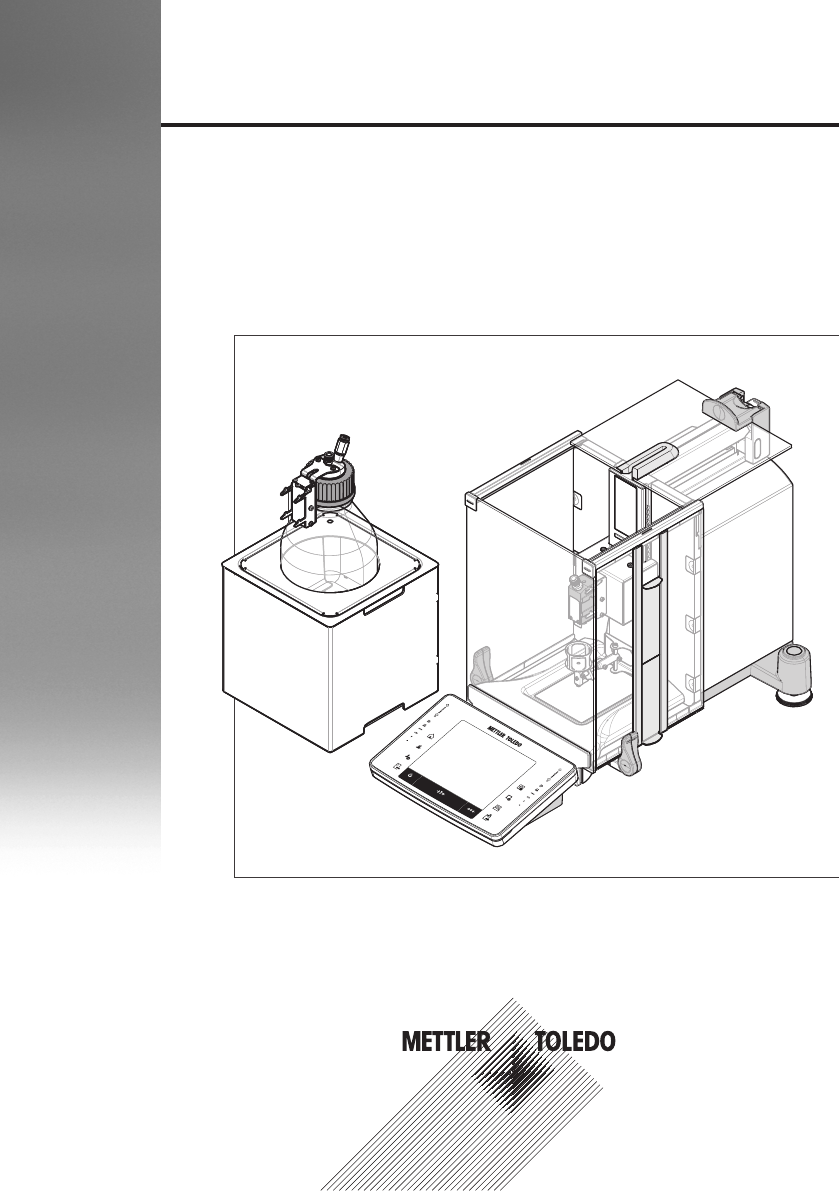
Quantos Automated Dosing
Liquid Module
User Manual
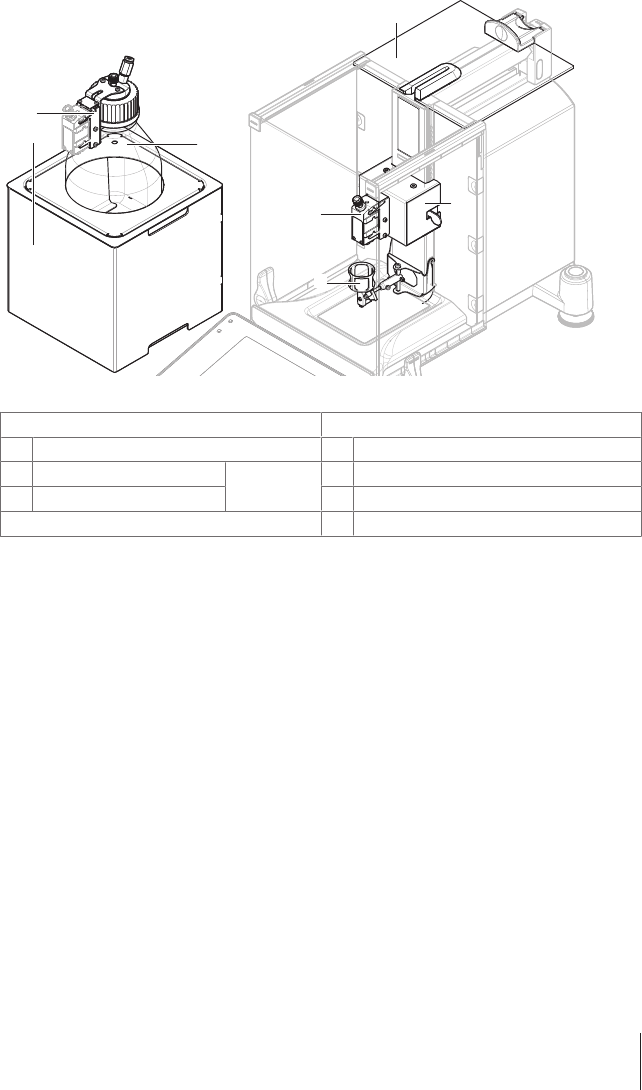
Overview Liquid module
2
1
4
3
5
6
7
Legend Liquid Module
Pump module with bottle Liquid kit with liquid dosing head
1Pump module (QL2) 4Top glass liquid
2Liquid dosing head support (QLL1000) 5Liquid dosing head (QL001)
3Bottle 6Liquid kit (QLX45)
7ErgoClip vial
3Quantos Automated Dosing
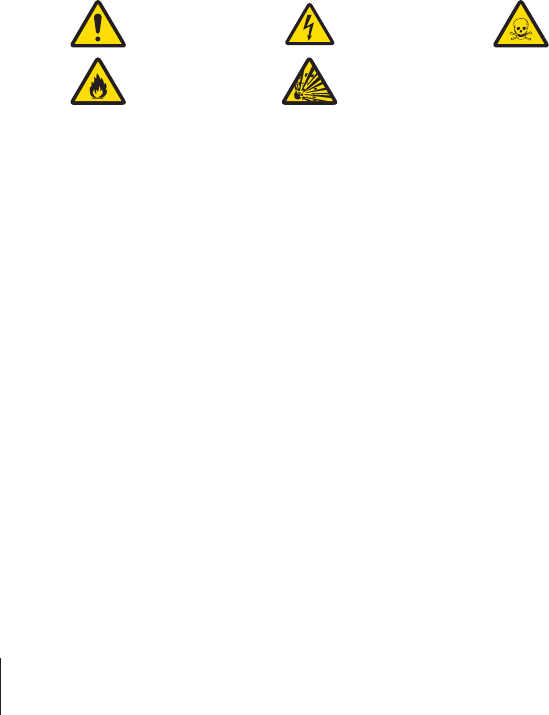
1 Safety Information
•Read and understand the instructions in this manual before you use the device.
•Keep this manual for future reference.
•Include this manual if you pass on the device to other parties.
If the device is not used according to the instructions in this manual or if it is modified, the safety of
the user may be impaired and Mettler-Toledo GmbH assumes no liability.
1.1 Definition of signal words and warning symbols
Signal Words
WARNING for a hazardous situation with medium risk, possibly resulting in death or severe
injury if not avoided.
CAUTION for a hazardous situation with low risk, resulting in minor or moderate injury if not
avoided.
NOTICE for a hazardous situation with low risk, resulting in damage to the instrument, other
material damage, malfunctions and erroneous results, or loss of data.
Note (no symbol)
for useful information about the product.
Symbols
General hazard Electrical shock Toxic substance
Inflammable or
explosive substance
Explosion
1.2 Product specific safety notes
Your dosing system represents state-of-the-art technology and complies with all recognized safety
rules, however, certain hazards may arise in extraneous circumstances. Do not open the device; it
does not contain any parts that can be maintained, repaired or replaced by the user. If you experience
problems with your dosing system, contact your authorized METTLER TOLEDO dealer or service repre-
sentative.
The dosing system has been tested for the experiments and intended purposes documented in the
appropriate manual. However, this does not absolve you from the responsibility of performing your
own tests of the products supplied by us regarding their suitability for the methods and purposes you
intend to use them for.
Intended use
This dosing system is designed to be used in analytical laboratories by qualified staff. Your dosing
system is used for weighing and dosing powder or liquid samples. Use the dosing system exclusively
for this purpose.
Any other type of use and operation beyond the limits of technical specifications without written
consent from Mettler-Toledo GmbH, is considered as not intended.
Site requirements
The balance has been developed for indoor operation in a well-ventilated area. Avoid the following
environmental influences:
•Conditions outside of the ambient conditions specified in the technical data
•Powerful vibrations
•Direct sunlight
•Corrosive gas atmosphere
4 Quantos Automated Dosing

•Explosive atmosphere of gases, steam, fog, dust and flammable dust
•Powerful electric or magnetic fields
Staff qualification
Incorrect use of the dosing system or the chemicals used in the analysis can lead to death or injury.
The following experience is needed for operating the dosing system.
•Knowledge and experience in working with toxic and caustic substances.
•Knowledge and experience in working with standard laboratory equipment.
•Knowledge and experience in working in accordance with general lab safety rules.
Responsibilities of the dosing system owner
The dosing system owner is the person that uses the dosing system for commercial use or places the
dosing system at the disposal of his staff. The dosing system owner is responsible for product safety
and the safety of staff, user(s) and third party.
The operator has the following responsibilities:
•Know the rules for safety at the workplace that are in effect and enforce them.
•Ensure that only qualified staff uses the dosing system.
•Define the responsibilities for installation, operation, cleaning, troubleshooting and maintenance
and ensure that the tasks are done.
•Train the staff in regular intervals and inform them about dangers.
•Provide the necessary protective gear for the staff.
Shut down of the instrument in emergency situations
− Pull the plug from the electrical outlet.
Protective clothing
Wear protective clothing in the laboratory when working with hazardous or toxic substances.
Wear suitable eye protection such as goggles.
Use appropriate gloves when handling chemicals or hazardous substances and check
their integrity before use.
Wear a lab coat.
5Quantos Automated Dosing
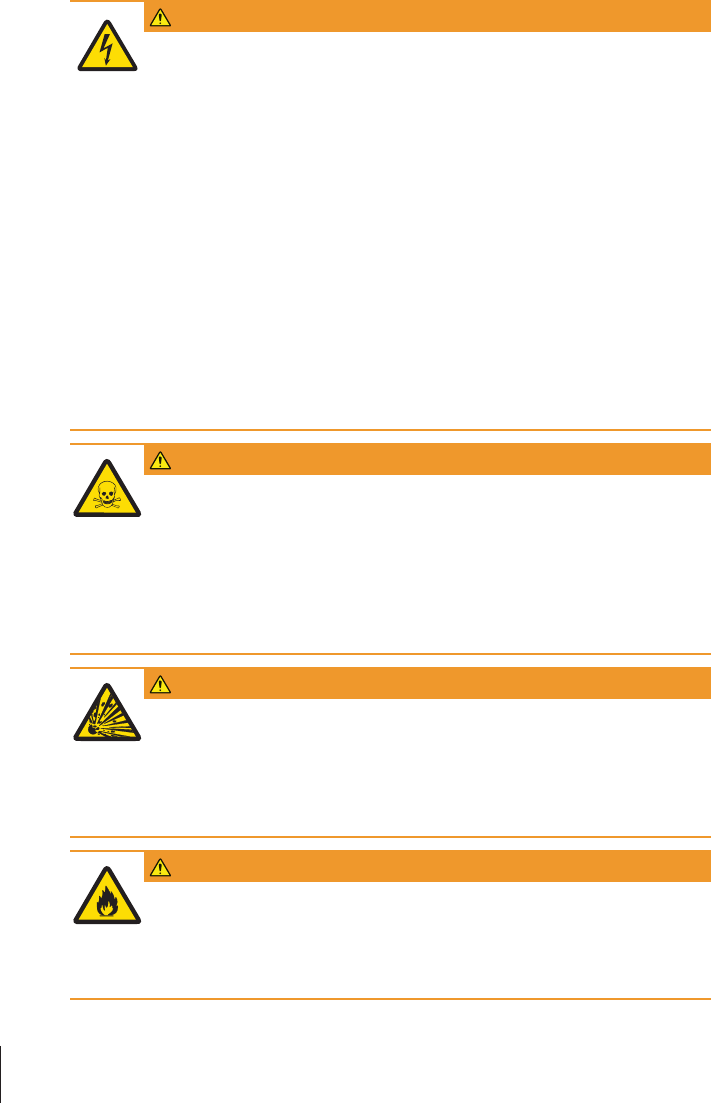
Safety notes
WARNING
Danger of death or serious injury due to electric shock!
Contact with parts that contain a live current can lead to injury and death. If the device
cannot be shut down in an emergency situations, people can be injured or the device
can be damaged.
1 Only use the supplied three-core power cable with equipment grounding conductor
to connect your device.
2 Check that the voltage printed on it is the same as your local power supply voltage.
ðIf this is not the case, under no circumstances connect the AC adapter to the
power supply, but contact a METTLER TOLEDO representative.
3 Only connect the instrument to a three-pin power socket with earthing contact.
4 Only standardized extension cable with equipment grounding conductor must be
used for operation of the device.
5 Do not disconnection the equipment grounding conductor.
6 Check the cables and the plug for damage and replace damaged cables and plugs.
7 Make sure that the cables are arranged so that they cannot be damaged or interfere
with the operation.
8 Keep all electrical cables and connections away from liquids.
9 Make sure that the power plug is accessible at all times.
WARNING
Danger of injuries and death due to toxic substances or caustic components!
Chemicals can cause injuries if they come in contact with bare skin, eyes or are
inhaled.
1 When using chemicals and solvents, comply with the instructions of the producer
and the general lab safety rules.
2 Set up the instrument in a well-ventilated location.
3 Clean any spills immediately.
4 If you dry substances which form toxic gases, place the instrument in a fume hood.
WARNING
Damage of bottle or pump because of high pressure!
If the bottle or the pump with a protective gas exposed to high pressure, the bottle or the
pump module might get damaged.
1 Avoid pressure higher than 1.5 bar (21 psi) in the bottle.
2 Ensure the protective gas does not exceed the pressure range of 0.2 bar (2.9 psi).
3 Wear protective glasses when working with the bottle.
WARNING
Danger of death and serious injuries due to flammable solvents!
Flammable solvents can ignite and lead to fire and explosions.
1 Keep flammable solvents away from naked flames.
2 When using chemicals and solvents, comply with the instructions of the producer
and the general lab safety rules.
6 Quantos Automated Dosing
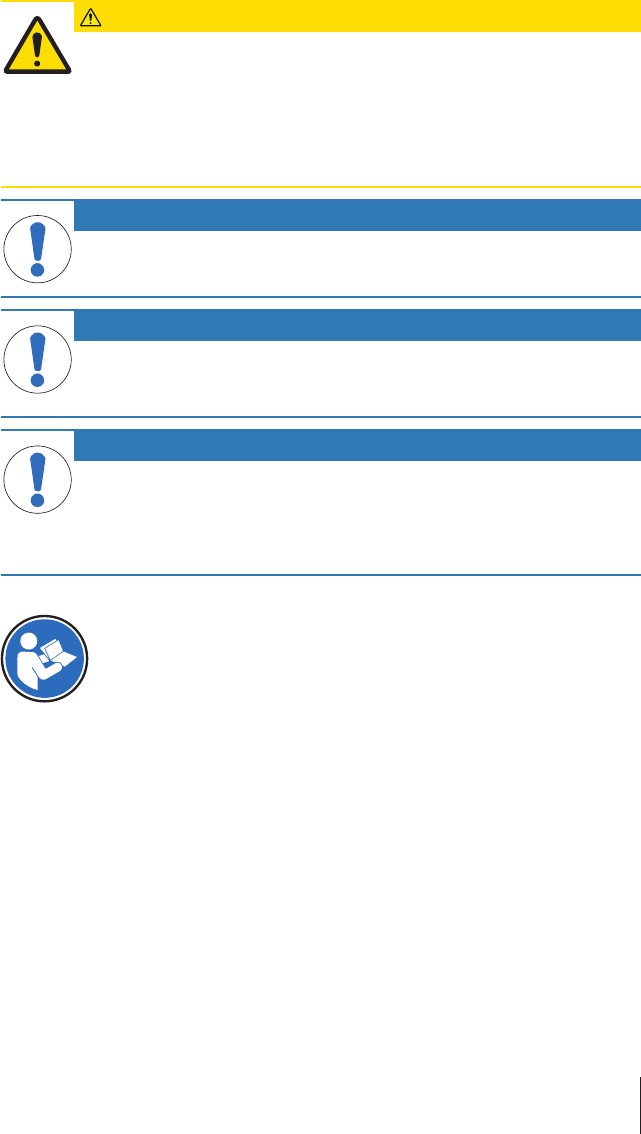
CAUTION
Danger of injuries due to splashing liquids!
Splashing liquids because of remaining pressure in dosing head. If you don't release
the pressure of the dosing head, liquid might splash when opening dosing head or
removing liquid tube.
1 Always release pressure of dosing head by switching off the instrument before
removing liquid tube.
2 Wear protective glasses.
NOTICE
Environment
Only use indoors in dry locations.
NOTICE
Danger of damage to the device!
Never open the device. The device contains no user-serviceable parts.
− In the event of problems, please contact a METTLER TOLEDO representative.
NOTICE
Danger of damage to the device due to incorrect parts!
Using incorrect parts with the device can damage the device or cause the device to
malfunction.
− Only use parts supplied with the device, listed accessories and spare parts from
Mettler-Toledo GmbH.
Finding more information
Refers to an external document.
FCC Rules
This device complies with Industry Canada licence-exempt RSS standard(s) and part 15 of the FCC
Rules. Operation is subject to the following two conditions: (1) this device may not cause inter-
ference, and (2) this device must accept any interference, including interference that may cause
undesired operation of the device.
Changes or modifications not expressly approved by the party responsible for compliance could void
the user's authority to operate the equipment.
This equipment has been tested and found to comply with the limits for a Class A digital device,
pursuant to part 15 of the FCC Rules. These limits are designed to provide reasonable protection
against harmful interference when the equipment is operated in a commercial environment. This
equipment generates, uses, and can radiate radio frequency energy and, if not installed and used in
accordance with the instruction manual, may cause harmful interference to radio communications.
Operation of this equipment in a residential area is likely to cause harmful interference in which case
the user will be required to correct the interference at his own expense.
7Quantos Automated Dosing
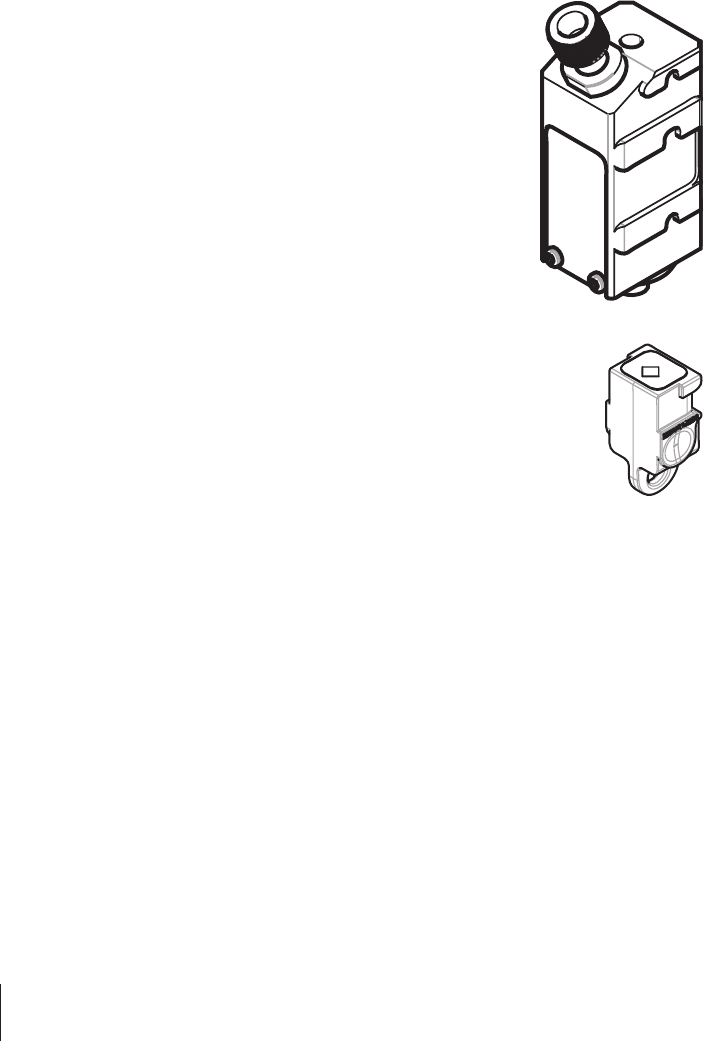
2 Design and Function
2.1 Dosing head
Liquid dosing head
This is the standard head for liquid dosing. It is used together
with pump module and bottle.
Manual dosing head
The manual dosing head is used for manual powder dosing. It
is equipped with a integrated RFID tag to store substance data
and to provide printing data.
Functional description
As soon as a head is inserted, the instrument automatically reads the data of the head. In addition,
the instrument performs automatic adjustments concerning the Dosing steps, automatic door
operation and other instrument settings.
When no dosing head is installed the instrument will replace head-specific information with factory
settings.
8 Quantos Automated Dosing

2.2 Data stored in the dosing head’s RFID
Every dosing head is equipped with a integrated RFID tag (1)
which stores and exchanges data with the instrument.
The following data is stored in the RFID tag of the head:
•User data
•This block holds information about the substance such as
the name of the substance, the filling and expiry dates, the
quantity, etc. This data can be edited by the user at any time
and should be entered before using a new head for the first
time to have the data available for reports and labels.
1
9Quantos Automated Dosing
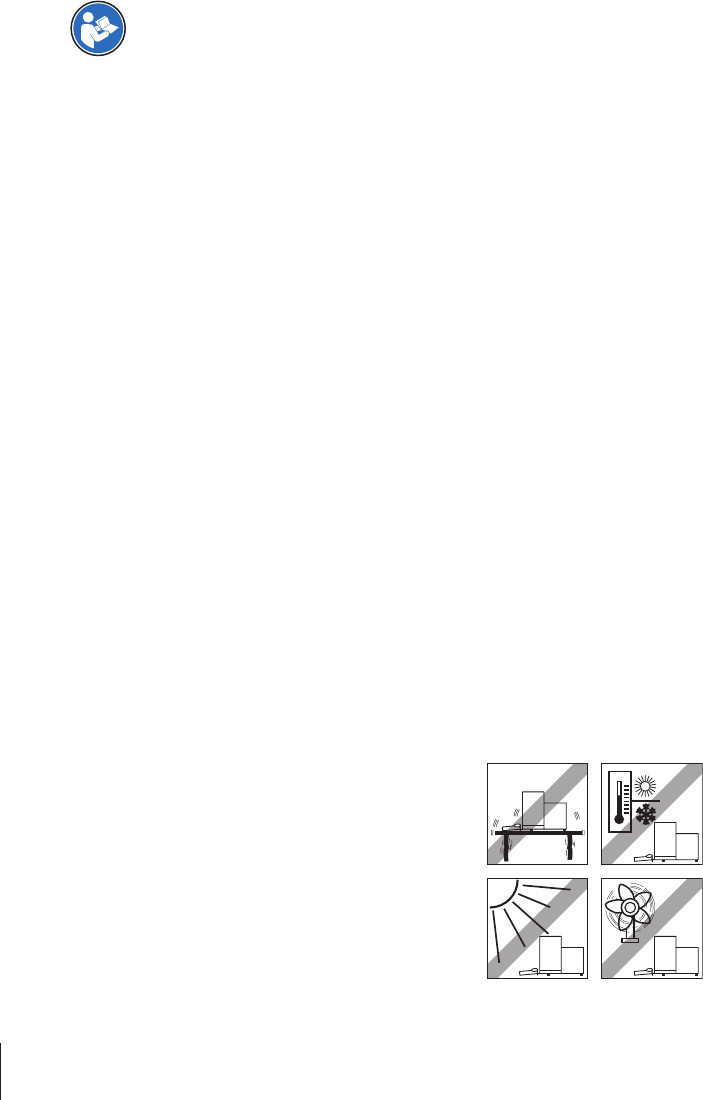
3 Installation and Putting into Operation
Additional information about this instrument can be found in the Operating Instructions on the
CD-ROM or online.
Finding more information
u www.mt.com/quantos
The instrument is installed by METTLER TOLEDO service engineers. This includes the wiring as well
as the configuration of the interfaces and peripherals.
3.1 Scope of delivery
Liquid module
Check the delivery for completeness. The following accessories are part of the standard equipment of
the liquid module:
•Liquid kit QLX45
– Liquid kit QLX45
– Top glass liquid
– ErgoClip vial
– SmartGrid round
– Vial adapter 5pcs
– MinWeigh door
– Screwdriver torx T8
– RS232C-cable
– RFID transponder 5pcs
– Power supply
– Cable conduct
– Cable clip (cable conduct closure)
– User Manual
•Liquid bottle and head QLL1000
– Liquid head QL001
– Bottle 1000ml pressure resistant
– Bottle cap with fitting and support
– Micro dosing valve tool
– Spare part set (incl. filter, ferrule, peek nut)
– Liquid tube
– Air tube
•Pump module QL2
– Pump QL2
– Liquid side doors for QL2
– Muffler
– Bottle holder
– Drip pan
– CAN-cable
3.2 Selecting the location
An optimal location will ensure accurate and reliable operation of the instrument. The surface must be
able to safely take the weight of the instrument when fully loaded. The following local conditions must
be observed:
If the instrument is not horizontal at the outset, it must be leveled during commissioning.
•The instrument must only be used indoors and up to a maximum
altitude of 4000 m above sea level.
•Before switching on the balance, wait until all parts are at room
temperature (+5 to 40°C).
The humidity must be between 10% and 80% non-condensing.
•The power plug must be accessible at all times.
•Firm, horizontal and vibration-free location.
•Avoid direct sunlight.
•No excessive temperature fluctuations.
•No strong drafts.
10 Quantos Automated Dosing
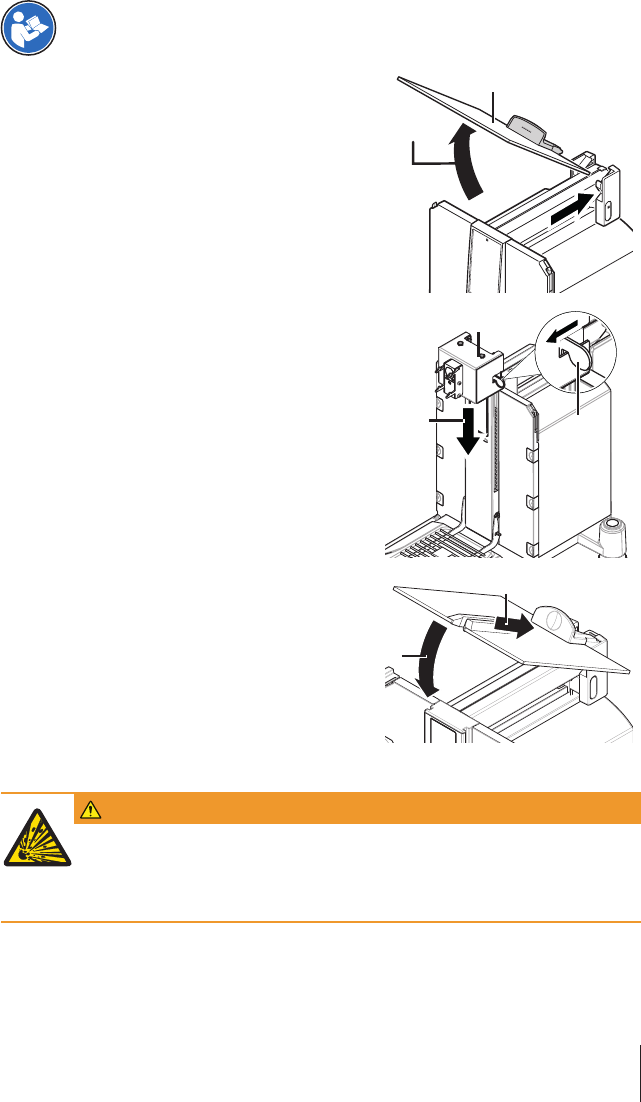
3.3 Assembling the liquid module
Assemble the balance according to your XPE Operating Instructions.
1 Remove top glass (1) by sliding it backwards and pulling it
upwards (2) carefully.
2
1
2 Insert the liquid kit (1), pull 2 levers (2) towards you and
slide liquid kit onto the rack.
Note
CAN-connector is on bottom of liquid kit.
3 To fix position of liquid kit, release 2 levers (2) and move
liquid kit slightly.
ðLiquid kit locks down.
ðLiquid kit is mounted.
3
2
1
4 Insert the top glass liquid (1) into the rear guide.
5 Carefully fold top glass liquid (2) downwards.
1
2
3.4 Assembling pump module and bottle
WARNING
Damage of bottle because of high pressure!
If the bottle has to resist higher pressure than 1.5 bar (21 psi) it might get damaged.
1 Avoid pressure higher than 1.5 bar (21 psi) in the bottle.
2 Wear protective glasses when working with the bottle.
11Quantos Automated Dosing
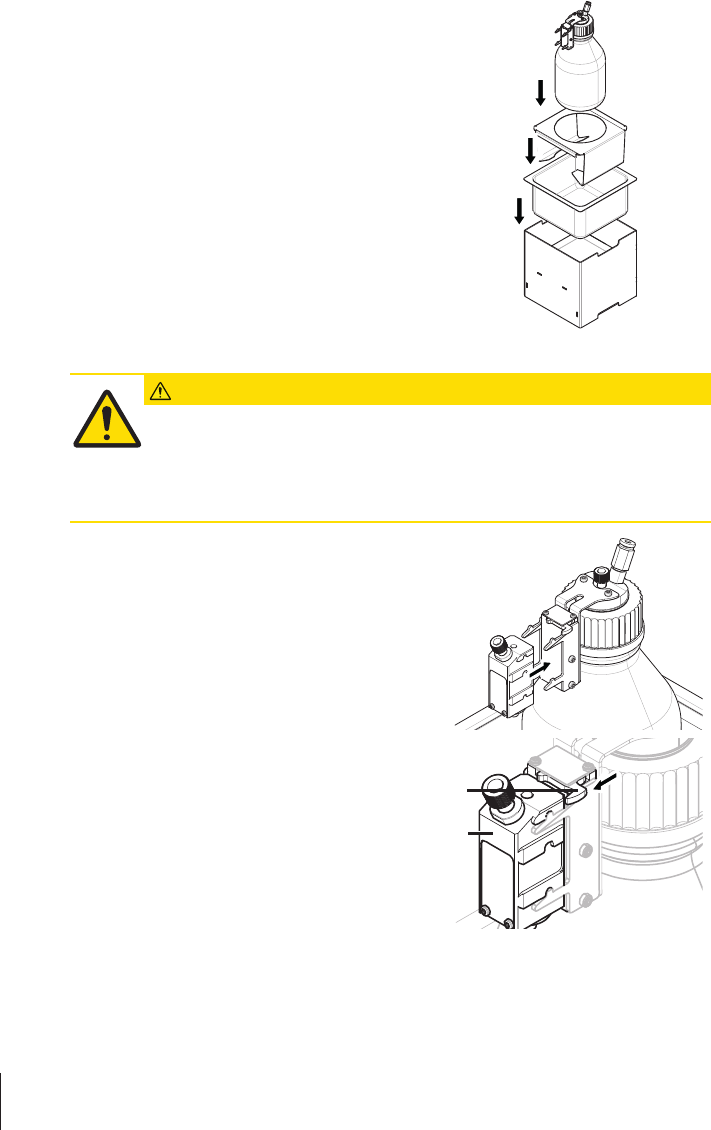
− Mount pump module and bottle according to figure.
Inserting and removing liquid dosing head in and from the liquid dosing head support
CAUTION
Danger of injuries due to splashing liquids or substances!
The bottle stands during use under 0.5 bar (7 psi) pressure. Liquid splashing out might
harm the user and can damage the device.
1 Do not remove tubes under pressure.
2 Relieve pressure by switching off the insrument, pull out the tube.
1 Insert liquid dosing head in the liquid dosing head support.
2 To remove liquid dosing head from the liquid dosing head
support, pull the catch (1) to the front and remove liquid
dosing head (2).
1
2
12 Quantos Automated Dosing
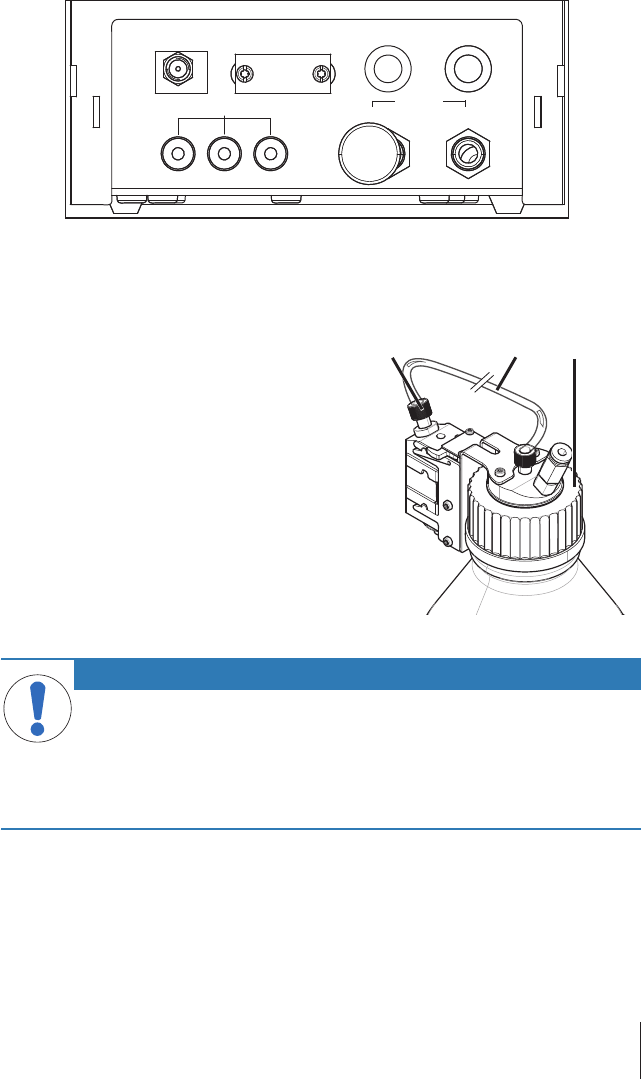
3.4.1 Connecting the tubes
Connectors of pump module
To Bottle PumpExhaustInlet
CAN CANRS232CPower Supply
The thinner tube is used for transporting liquid from the bottle to the liquid dosing head. The slightly
bigger tube is used for pumping air into the bottle. By adding air, pressure rises in the bottle. When
pressure reaches min. 0.3 to max 0.5 bar (4.4 to 7.2 psi) the micro dispensing valve in the dosing
head opens and liquid can ascend the liquid tube. The two tubes are further referred to as liquid tube
and air tube.
§The liquid dosing head is inserted in the liquid dosing head
support.
− Connect liquid tube (1) at bottle (2) and at liquid dosing
head (3).
1 2
3
Connect air tube
NOTICE
Damage on tube connectors because of mishandling!
If the tubes are not removed correctly, the connectors and therefore the pump module
can be damaged.
Wrongly cut tubing can cause leaking connections.
1 To remove tubes, press down ring on connector and pull out tube carefully.
2 Cut tubes with a tube cutter.
A tube in the air inlet to bottle (5) opens the valve of the air outlet. Never leave a tube which is
connected to the air outlet unconnected at the other end because pressure can not be built up.
You can connect up to 3 bottles to the pump module (7).
13Quantos Automated Dosing
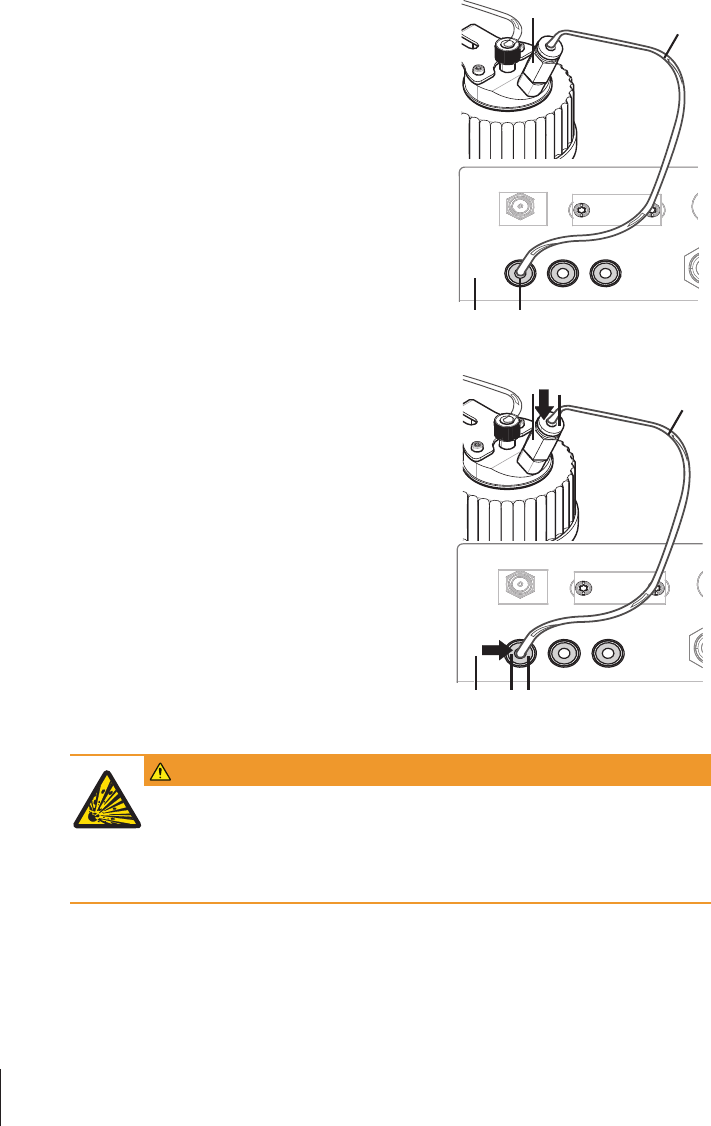
− Connect the air tube (4) at the air inlet of the bottle (5) and
the air outlet of the pump module (6).
5
4
67
Remove air tube
1 Remove air tube to the bottle (4) by firmly press lay down
the ring (8) at the air inlet (5).
2 Remove the air tubing of the bottle (8) and only if necessary
of the pump module by pushing the ring (9).
8
5
4
697
Use the pump with protective gas
WARNING
Damage of pump because of high pressure!
If you need to feed the pump with protective gas, e.g. nitrogen, make sure it does not
exceed the pressure range of 0.2 bar (2.9 psi). The pump module might get damaged.
1 Ensure the protective gas does not exceed the pressure range of 0.2 bar (2.9 psi).
2 Wear protective glasses when working with the pump.
14 Quantos Automated Dosing
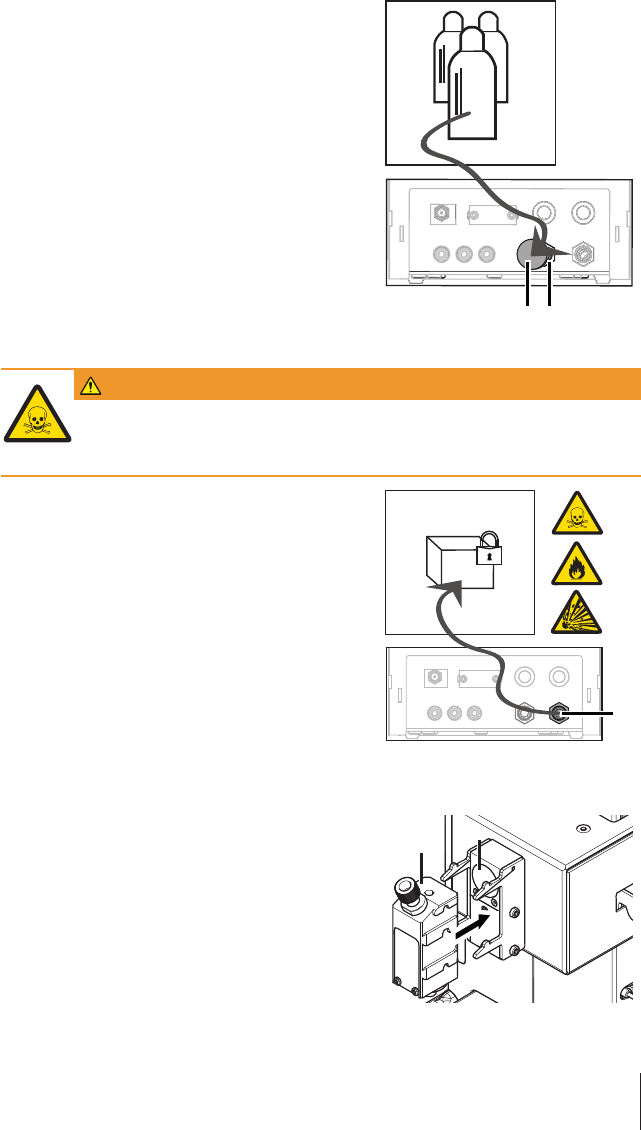
1 Insert muffler (10) into air inlet (11) to absorb noise.
2 If you need to feed the pump with protective gas, e.g.
nitrogen, make sure it does not exceed the pressure range of
0.2 bar (2.9 psi).
Wear protective glasses.
Do not insert the muffler (11) but instead connect a tube to
the air inlet (11).
Note
Outer tube diameter: 6mm
Pressure range: 0.1 to 0.2bar (1.5 to 2.9psi)
10 11
Contaminated air by using toxic, explosive or flammable liquids!
WARNING
Danger of injuries and death due to toxic substances!
If you use toxic, explosive or flammable liquids, the exhaust air will be contaminated.
− Use a tube for the exhaust air outlet.
1 If you use toxic, explosive or flammable liquids, the exhaust
air will be contaminated and the device can get damaged.
2 Connect a tube to exhaust air (12) outlet to absorb the air
into a safe container.
Note
Outer tube diameter: 6mm
12
3.5 Installing liquid dosing head
Installing liquid dosing head on liquid kit
1 Slide the liquid dosing head (1) onto the liquid kit (2) until it
comes to a stop.
2 Press it down slightly until it is properly seated in the
holding pins.
Important
Check that dosing head is inserted correctly.
If there is just a small gap between dosing head and its
support, press it down again.
3 Thread the liquid tube through slot in Quantos top glass.
12
15Quantos Automated Dosing
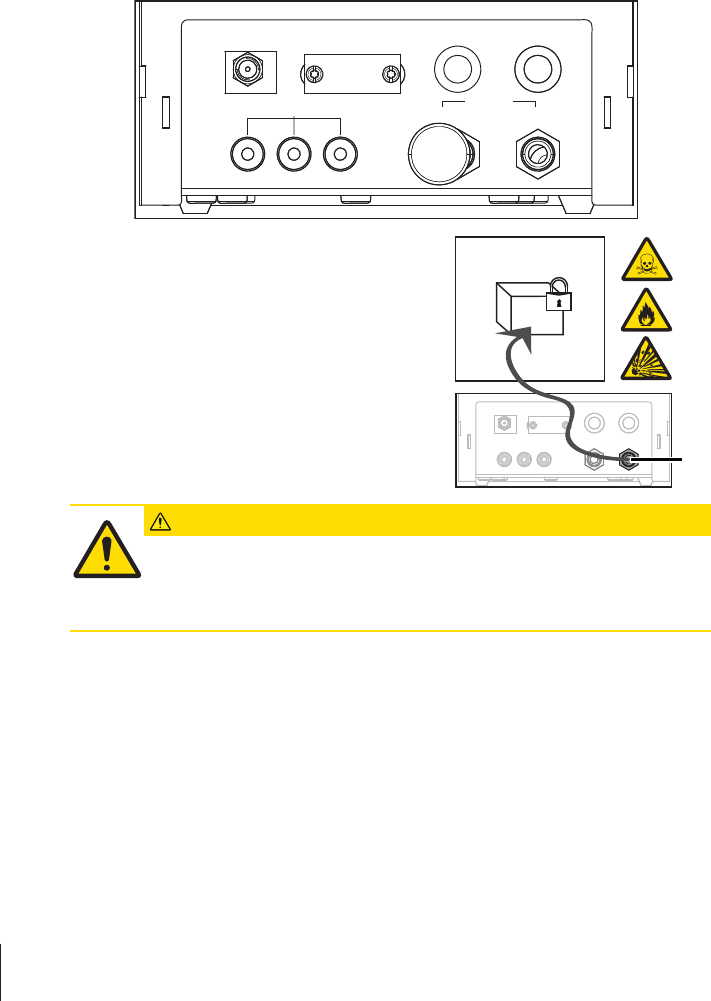
Removing liquid dosing head from liquid kit
− To remove the liquid dosing head, press it slightly upwards
and remove it to the front.
3.6 Connecting the tubes
Connectors of pump module
To Bottle PumpExhaustInlet
CAN CANRS232CPower Supply
1WARNINGContaminated air!
If you use toxic, explosive or flammable liquids, the exhaust
air will be contaminated and the device can get damaged.
Connect a tube to exhaust air outlet to absorb the air into a
safe container.
Note
Outer tube diameter: 6mm
12
CAUTION
Damage on tube connectors because of mishandling!
If the tubes are not removed correctly, the connectors and therefore the pump module
can get damaged.
− To remove tubes, press down ring on connector and pull out tube carefully.
16 Quantos Automated Dosing
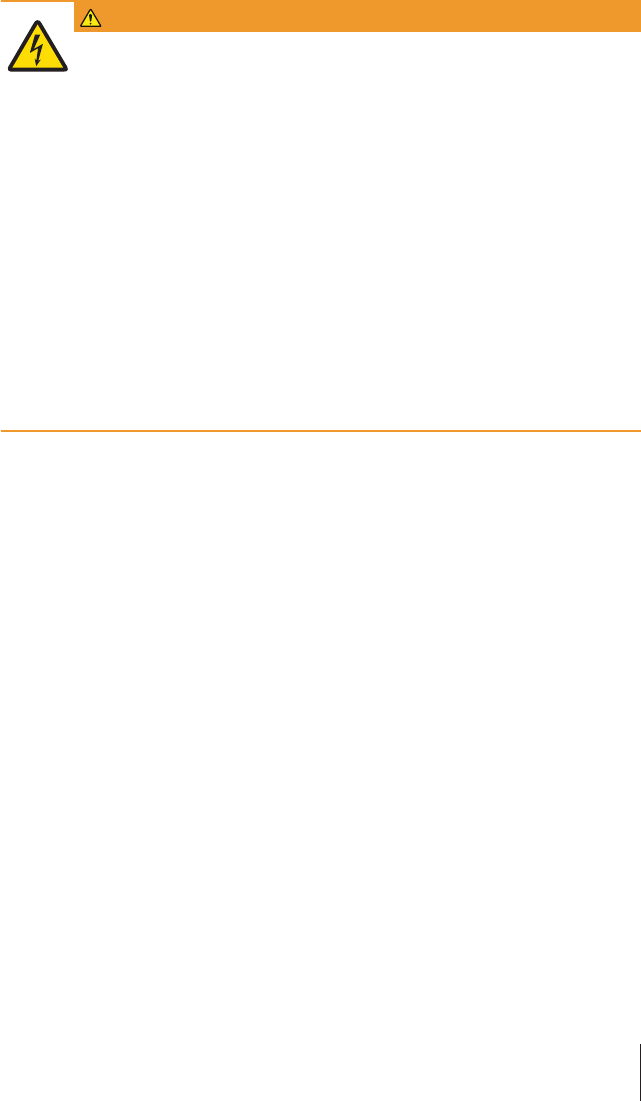
3.7 Wiring the liquid module
WARNING
Danger of death or serious injury due to electric shock!
Contact with parts that contain a live current can lead to injury and death. If the
instrument cannot be shut down in an emergency situations, people can be injured or
the instrument can be damaged.
1 To connect the pump module, only use the supplied three-core power cable with
equipment grounding conductor.
2 Only connect the pump module to a three-pin power socket with earthing contact.
3 Only standardized extension cable with equipment grounding conductor must be
used for operation of the pump module.
4 Do not disconnection the equipment grounding conductor.
5 Check that the voltage printed on it is the same as your local power supply voltage.
ðIf this is not the case, under no circumstances connect the AC adapter to the
power supply, but contact a METTLER TOLEDO representative.
6 Check the cables and the plug for damage and replace damaged cables and plugs.
7 Make sure that the cables are arranged so that they cannot be damaged or interfere
with the operation.
8 Keep all electrical cables and connections away from liquids.
9 Make sure that the power plug is accessible at all times.
The balance is supplied with an AC/DC adapter and a country-specific power cable. The AC/DC
adapter is suitable for use with the following voltage range:
100 – 240 VAC, 50/60Hz.
NOTICE
•Check whether your local power supply falls within this range. If this is not the case, under no
circumstances connect the AC/DC adapter to the power supply, but contact a METTLER TOLEDO
representative.
•The power plug must be accessible at all times.
•Prior to use, check the power cable for damage.
•Route the cable in such a way that it cannot be damaged or cause a hindrance when working.
•Ensure that no liquid comes into contact with the AC/DC adapter.
Important
Wire the components before turning the balance on.
After turning the balance on, if the message Wrong head type mounted appears, check wires.
Make sure you connect CAN-cables before connecting power supplies.
17Quantos Automated Dosing
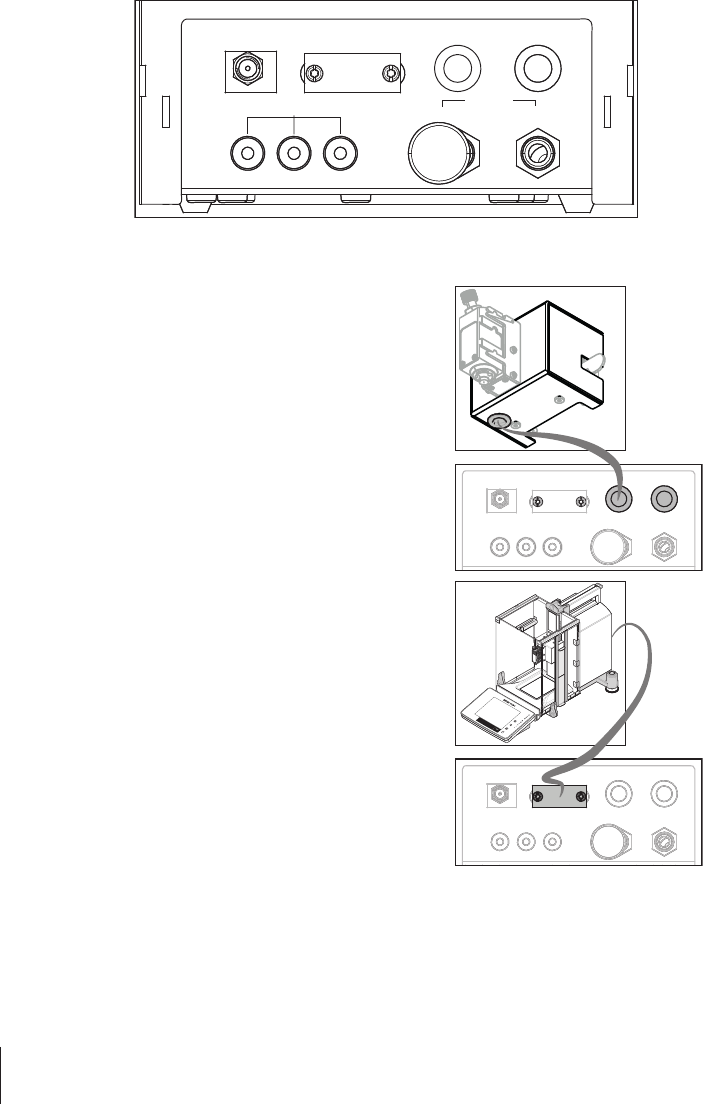
Connectors of pump module
To Bottle PumpExhaustInlet
CAN CANRS232CPower Supply
Note
Power supply and RS232C Connector are covered with a faceplate. Remove faceplate.
1 Connect pump module with liquid kit via CAN-cable.
There are 2 CAN-connectors on the pump module. There is
no preference which one to take.
2 Remove left side glass and exchange one clip with the cable
clip included in the scope of delivery.
3 Guide CAN-cable through cable clip and insert left side
glass.
4 Connect pump module with balance via standard RS232C-
cable.
ðLiquid module is connected.
18 Quantos Automated Dosing

1 Connect power cable of liquid module to power socket and
local power supply.
2 Connect power cable of balance to power socket and local
power supply.
19Quantos Automated Dosing
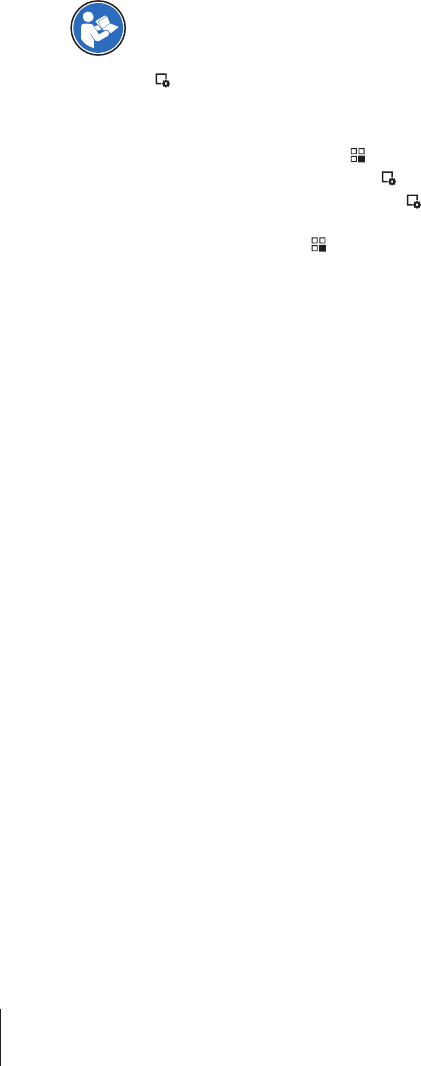
4 Operation
4.1 Basic operation settings
Refer to your XPE Operating Instructions for further information on settings and parameters.
Navigation: [ ] > Liquid module... [Define] > Mounted... [Define]
If you dose liquid for the first time, or after a master reset, check following settings:
Configure your settings in the following menu:
•Dosing must be chosen as application: [ ] > [Dosing]
•Liquid module must be defined as mounted: [ ] > Liquid module… [Define] > [Mounted]
•Powder module must be defined as unmounted: [ ] > Powder module… [Define] >
[Unmounted]
•RS232 device must be activated: [ ] > [System] > [Peripherals] > RFID / Quantos… [RS232
built-in] > [RS232 built-in]
4.2 Dosing liquid
§Liquid dosing head is installed.
§Weighing pan is empty.
§If required, ErgoClip is installed.
1 Tap [Start] > [Liquid dosing].
2 Enter User ID and confirm with [OK].
3Note
The Sample ID is not mandatory and the instrument does not check whether or not it is unique.
Enter Sample ID and confirm with [OK].
4 Enter the amount Target liquid [g] required and confirm with [OK].
5 Place sample vessel on weighing pan or ErgoClip and confirm with [OK].
6 Lower position of dosing head until it is about 1cm to 2cm above the sample vessel and
confirm with [OK].
7Note
To abort dosing during process, tap [C].
Check, if all necessary adjustments are completed:
To abort procedure, tap [No].
To start dosing, tap [Yes].
ðPressure builds up.
ðInstrument doses liquid.
ðThe results are being displayed.
8 To finish dosing process, confirm with [OK].
Congratulations, you have just successfully finished your first dosing!
Note
•Bubbles in the tube do not impair the result, because the target result is weighed.
•If you dose liquids that might crystalize, clean the dosing head from time to time.
Note
See Quantos Liquid Module Operating Instructions for further information on your possibilities with the
different dosing applications.
20 Quantos Automated Dosing
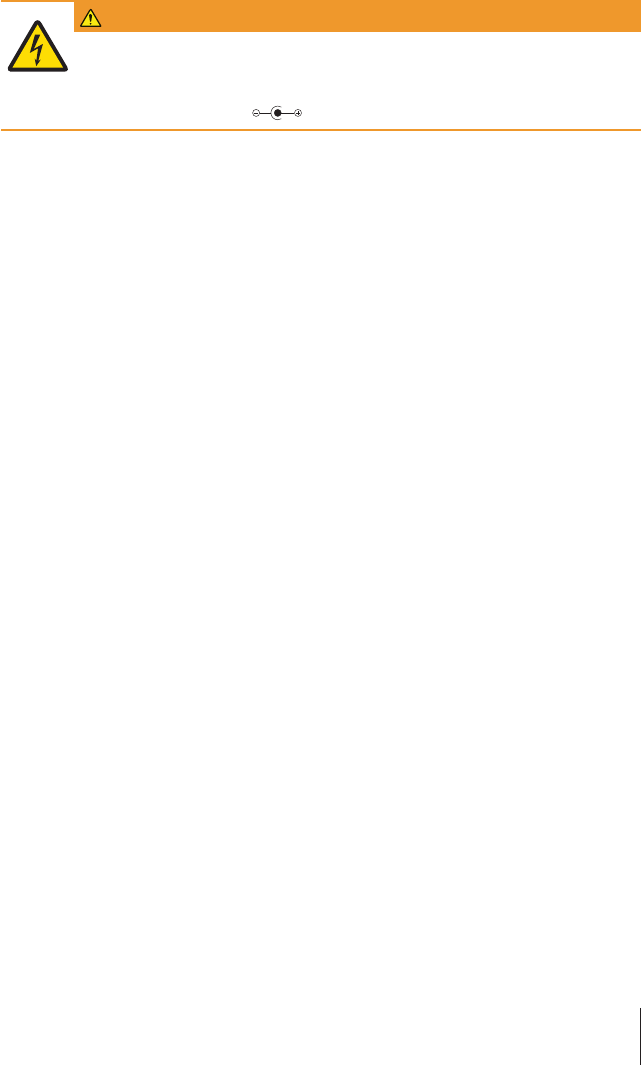
5 Technical Data
5.1 General data
WARNING
Danger of death or serious injury due to electric shock!
Contact with parts that contain a live current can lead to injury and death.
1 Only use an approved AC adapter with a current-limited SELV output.
2 Ensure correct polarity
Power supply
AC adapter: Primary: 100 – 240VAC, -15%/+10%, 50/60 Hz
Secondary: 12VDC ±3%, 2.5A (with electronic overload
protection)
Cable for AC adapter: 3-core, with country-specific plug
Balance power supply: 12 VDC ±3%, 2.5 A, maximum ripple: 80 mVpp
Protection and standards
Overvoltage category: II
Degree of pollution: 2
Protection: Protected against dust and water
Standards for safety and EMC: See Declaration of Conformity
Range of application: For use only in closed interior rooms
Environmental conditions
Height above mean sea level: Up to 4000m
Ambient temperature: 5–40°C
Relative air humidity: Max. 80% up to 31°C, linearly decreasing to 50% at 40°C,
noncondensing
21Quantos Automated Dosing

22 Quantos Automated Dosing
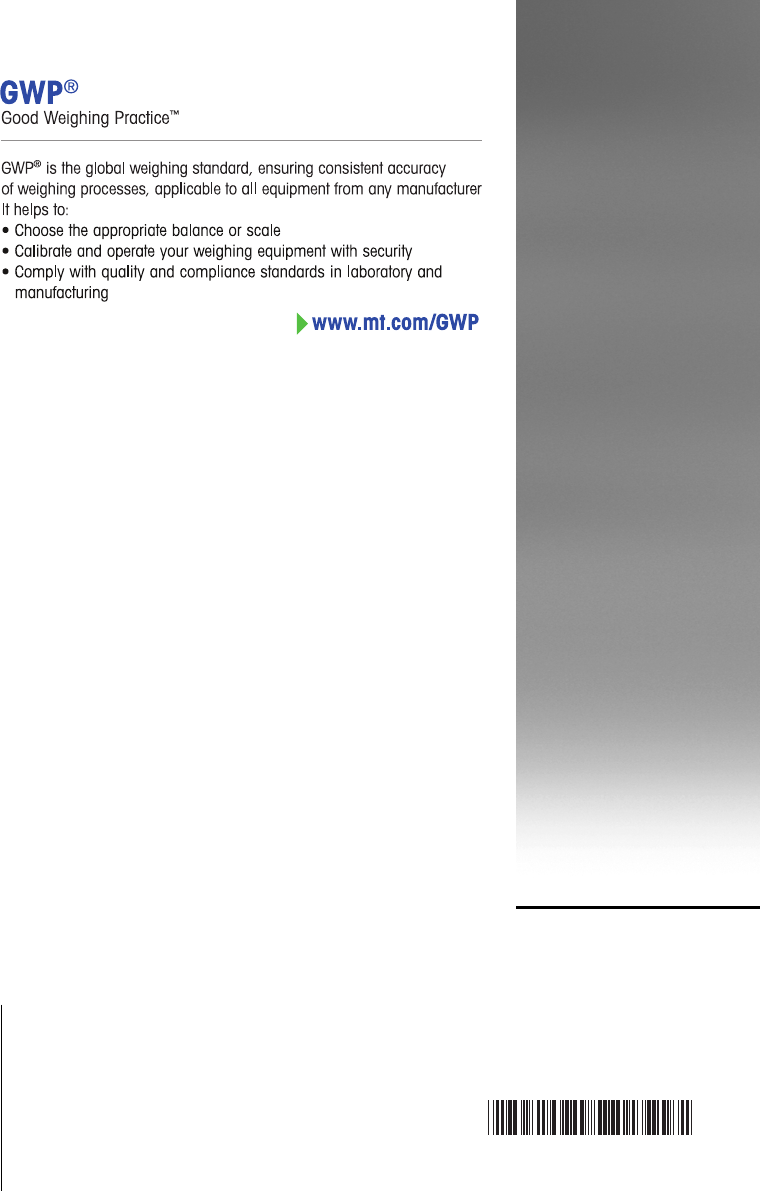
Mettler-Toledo GmbH
Im Langacher 44
8606 Greifensee, Switzerland
www.mt.com/contact
Subject to technical changes.
© Mettler-Toledo GmbH 11/2016
30260315C en
For more information
www.mt.com/quantos
30260315